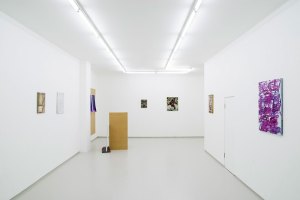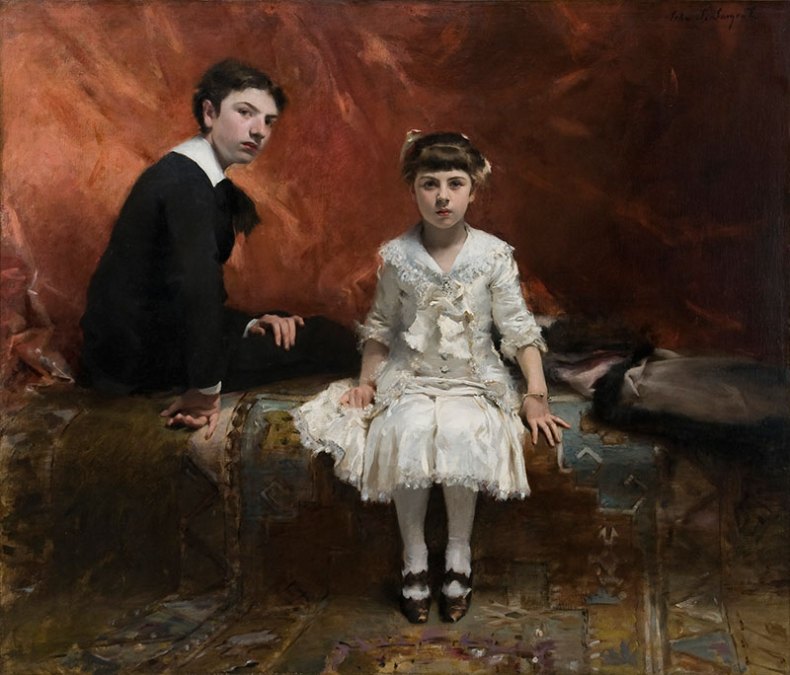Digby Warde-Aldam surveys the London art scene…
My job – if it can be so described – requires me to get out and see as many exhibitions as possible every week, from museum blockbusters to the most amateurish of pop-up shows. Most are unremarkable at best. But it never ceases to amaze me quite how many art galleries this city can house, and the odds are that something, somewhere, will make all the footslogging worth it.

‘Promise of Palm Trees’ (installation view; January 2015) Photo Tom Horak. Courtesy Breese Little
Granted, I’ve seen some rubbish over the past few weeks, but I’ve been to a couple of knockouts, too, such as ‘Promise of Palm Trees’ (now closed), a superb show at Clerkenwell’s Breese Little gallery. It’s a long time since abstract painting was last in fashion, and all too often we think of the genre as a byword for artistic self-indulgence. But this exhibition turns that prejudice on its head.
Another winner was Nick Fox’s delicate and imaginative show at the gratifyingly spooky Tudor relic that is Clapton’s Sutton House (until 31 March). Fox has scattered ceramics, sculpture and paintings throughout the building’s higgledy-piggledy layout, and the whole thing feels like a treasure hunt as organised by André Breton. It’s great fun.
◎
In Mayfair, two other commercial shows caught my imagination. First up was an exhibition of Barbara Kruger’s early work at Skarstedt (until 11 April). I’ve loved Kruger’s work since I first discovered it as a 10-year-old in Edinburgh, and this display is like a greatest hits of her deadpan riffs on the language of advertising.
I’ve never been head-over-heels for Tuymans. He’s a first-rate painter with an intellect to match, but there’s something about his work that is just a little too distant, too knowing. It is (ironically?) detached even when it deals with subjects like mass slaughter and colonialism. But his highly publicised new show at David Zwirner on Grafton Street (until 2 April) has done a lot to win me over.
Related: ‘Never Surrender’ – Luc Tuymans speaks out at his London show
It was a triptych of small paintings, based on Henry Raeburn’s portraits of Scottish Enlightenment figures that did it for me. At first glance, they’re nothing more than faithful copies. But look closer and Raeburn’s figurative constructions disintegrate into consciously rough blotches of colour. They’re every bit as abstract as the stuff I saw at Breese Little. Tuymans has spoken of his excitement on discovering Raeburn as a teenager, and the love is obviously still there. These three paintings are, I think, a sincere homage to one of his heroes.
◎
Tuymans isn’t the only artist who paints his subjects at one remove. A mile away at Tate Modern, a Marlene Dumas retrospective (until 10 May) – the South African-born painter’s first in this country – has chalked up rave reviews. Dumas is a superlative portrait artist who uses photographs as source material. The work on show is mostly terrific – check out Death of the Author, or her extraordinary Rejects series for proof. But there are a couple of misfires.
Most awkward of these, perhaps, is a painting of Princess Diana based on a photograph by Lord Snowdon. Diana Spencer is still a contentious subject in this country, to an extent that outsiders may find difficult – indeed, baffling – to understand. The portrait is part of a diptych, the other half of which is a naïf painting of model Naomi Campbell. Its title: Great Britain. I don’t know how you’d look at it in Dumas’s adopted home of Amsterdam. But in London, you can’t help but feel the whole endeavour is just a little gawky.
◎

Édouard and Marie-Louise Pailleron (1881), John Singer Sargent © Des Moines Art Center, Des Moines, Iowa
The National Portrait Gallery’s ‘Sargent: Portraits of Artists and Friends’ (until 25 May) is a great foil for Dumas and Tuymans’ exhibitions. I’m pleased we’re re-examining John Singer Sargent’s work. In the last decade of the 19th century, he was the chattering classes’ most in-demand portraitist – but as it became clear that Cubism was more than a flash in the pan, he fell out of fashion hard and fast.
A lot of people still think of Sargent as a skilled painter with neither head nor heart. But with certain works, I don’t think he’s a million miles away from the territory Dumas has staked as her own. Take a look at his Édouard and Marie-Louise Pailleron (1881) and tell me it’s any less a disquieting vision of childhood than Dumas’s The Teacher (Sub A) (1987).
◎
Just one more thing; I’m desperate to get to the Barbican’s ‘Magnificent Obsessions: The Artist as Collector’, but nobody wants to go with me. Any takers? Get in touch @dailyrecord2.
Related Articles
‘Never Surrender’ – Luc Tuymans speaks out at his London show (Fatema Ahmed)
‘Magnificent Obsessions’, magnificent show (Katy Barrett)
Digby’s Frieze Week Diary

London Diary: 22 February
'Promise of Palm Trees' (installation view; January 2015) Photo Tom Horak. Courtesy Breese Little
Share
Digby Warde-Aldam surveys the London art scene…
My job – if it can be so described – requires me to get out and see as many exhibitions as possible every week, from museum blockbusters to the most amateurish of pop-up shows. Most are unremarkable at best. But it never ceases to amaze me quite how many art galleries this city can house, and the odds are that something, somewhere, will make all the footslogging worth it.
‘Promise of Palm Trees’ (installation view; January 2015) Photo Tom Horak. Courtesy Breese Little
Granted, I’ve seen some rubbish over the past few weeks, but I’ve been to a couple of knockouts, too, such as ‘Promise of Palm Trees’ (now closed), a superb show at Clerkenwell’s Breese Little gallery. It’s a long time since abstract painting was last in fashion, and all too often we think of the genre as a byword for artistic self-indulgence. But this exhibition turns that prejudice on its head.
Another winner was Nick Fox’s delicate and imaginative show at the gratifyingly spooky Tudor relic that is Clapton’s Sutton House (until 31 March). Fox has scattered ceramics, sculpture and paintings throughout the building’s higgledy-piggledy layout, and the whole thing feels like a treasure hunt as organised by André Breton. It’s great fun.
◎
In Mayfair, two other commercial shows caught my imagination. First up was an exhibition of Barbara Kruger’s early work at Skarstedt (until 11 April). I’ve loved Kruger’s work since I first discovered it as a 10-year-old in Edinburgh, and this display is like a greatest hits of her deadpan riffs on the language of advertising.
I’ve never been head-over-heels for Tuymans. He’s a first-rate painter with an intellect to match, but there’s something about his work that is just a little too distant, too knowing. It is (ironically?) detached even when it deals with subjects like mass slaughter and colonialism. But his highly publicised new show at David Zwirner on Grafton Street (until 2 April) has done a lot to win me over.
Related: ‘Never Surrender’ – Luc Tuymans speaks out at his London show
It was a triptych of small paintings, based on Henry Raeburn’s portraits of Scottish Enlightenment figures that did it for me. At first glance, they’re nothing more than faithful copies. But look closer and Raeburn’s figurative constructions disintegrate into consciously rough blotches of colour. They’re every bit as abstract as the stuff I saw at Breese Little. Tuymans has spoken of his excitement on discovering Raeburn as a teenager, and the love is obviously still there. These three paintings are, I think, a sincere homage to one of his heroes.
◎
Tuymans isn’t the only artist who paints his subjects at one remove. A mile away at Tate Modern, a Marlene Dumas retrospective (until 10 May) – the South African-born painter’s first in this country – has chalked up rave reviews. Dumas is a superlative portrait artist who uses photographs as source material. The work on show is mostly terrific – check out Death of the Author, or her extraordinary Rejects series for proof. But there are a couple of misfires.
Most awkward of these, perhaps, is a painting of Princess Diana based on a photograph by Lord Snowdon. Diana Spencer is still a contentious subject in this country, to an extent that outsiders may find difficult – indeed, baffling – to understand. The portrait is part of a diptych, the other half of which is a naïf painting of model Naomi Campbell. Its title: Great Britain. I don’t know how you’d look at it in Dumas’s adopted home of Amsterdam. But in London, you can’t help but feel the whole endeavour is just a little gawky.
◎
Édouard and Marie-Louise Pailleron (1881), John Singer Sargent © Des Moines Art Center, Des Moines, Iowa
The National Portrait Gallery’s ‘Sargent: Portraits of Artists and Friends’ (until 25 May) is a great foil for Dumas and Tuymans’ exhibitions. I’m pleased we’re re-examining John Singer Sargent’s work. In the last decade of the 19th century, he was the chattering classes’ most in-demand portraitist – but as it became clear that Cubism was more than a flash in the pan, he fell out of fashion hard and fast.
A lot of people still think of Sargent as a skilled painter with neither head nor heart. But with certain works, I don’t think he’s a million miles away from the territory Dumas has staked as her own. Take a look at his Édouard and Marie-Louise Pailleron (1881) and tell me it’s any less a disquieting vision of childhood than Dumas’s The Teacher (Sub A) (1987).
◎
Just one more thing; I’m desperate to get to the Barbican’s ‘Magnificent Obsessions: The Artist as Collector’, but nobody wants to go with me. Any takers? Get in touch @dailyrecord2.
Related Articles
‘Never Surrender’ – Luc Tuymans speaks out at his London show (Fatema Ahmed)
‘Magnificent Obsessions’, magnificent show (Katy Barrett)
Digby’s Frieze Week Diary
Unlimited access from just $16 every 3 months
Subscribe to get unlimited and exclusive access to the top art stories, interviews and exhibition reviews.
Share
Recommended for you
Affordable Art
A new 50p piece, designed by Tom Phillips to celebrate the centenary of Benjamin Britten’s birth, attempts to ‘set the wild echoes flying’
The Apollo Podcast Film special: Mike Leigh on Mr. Turner
Thomas Marks is joined by the director to talk about his love of Turner’s work, and taking art to the movies
Why London doesn’t need the Garden Bridge
The proposed Garden Bridge over the Thames is impractical as a park and misguided as a river crossing